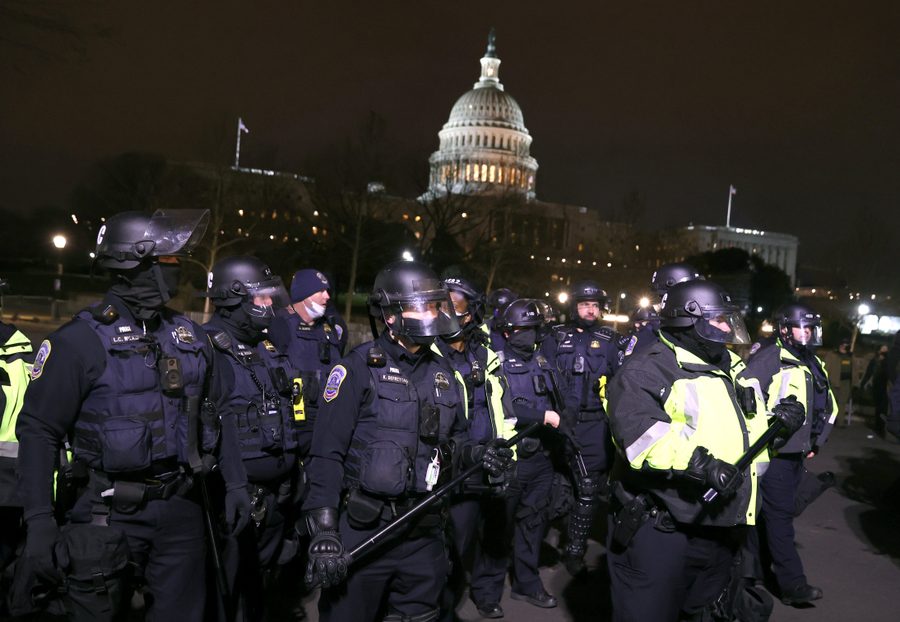How January 6 Is Being Used to Crush Dissent on the Left
Rather than grapple with the political forces behind the Capitol siege, lawmakers have instead pushed a spate of anti-protest laws across the country.
Branko Marcetic

On January 6 of last year, convinced that Donald Trump’s loss to Joe Biden in the 2020 presidential race was the result of a rigged election, hundreds of his supporters breached the United States Capitol to interrupt the certification of the election results in Congress — to “stop the steal,” as they put it. They had been egged on by a constellation of right-wing corporate media outlets, Republican officials and, of course, Trump himself.
A nation and world looked on aghast as a motley band of protesters — from realtors who arrived in a private jet and moms and dads who drove in from far-off suburbs to bizarrely dressed QAnon believers, militia members and full-on white supremacists — stalked the Capitol halls, taking selfies, looting congressional offices and searching for elected officials, all in an attempt to overturn a democratic election.
The Capitol riot has frequently been compared to the 9/11 World Trade Center attacks, by media commenters, government officials and even former President George W. Bush. On the one hand, the comparison is absurd. While nearly 3,000 people were killed by terrorists 21 years ago, only five died in last year’s Capitol siege, four of them the rioters themselves — the “attackers,” in the analogy — and one officer, who died of a stroke after the event.
However, the two events do have some stark parallels. Each was an avoidable security failure, received a mountain of fear-inducing media coverage, and has since been used to justify further centralization of repressive government powers.
The response to the events of January 6 has been marked by a crackdown on dissent: a dramatic increase in anti-protest bills around the country, including at least 88 that have been introduced since the Capitol riot; a massive buildup of the Capitol police into a national force to target “terrorism;” as well as the rollout by the Biden administration of a sweeping domestic counter-terror strategy.
U.S. history shows that such expanded powers to crush protests wind up disproportionately impacting those on the Left, no matter what led to the laws’ passage in the first place. In many ways, the response to January 6 may wind up being more dangerous than the event itself.
The “domestic terror” threat
Shortly after the Capitol riot, Sen. Tom Cotton (R-Ark.), who had been widely pilloried for demanding in the New York Times that U.S. troops be sent in to quell racial justice protesters in the wake of George Floyd’s murder, published a near-identical op-ed celebrating that the country was now on his side. “Some liberals appear to have shed their reservations about the use of force now that the mob carries different signs and chants different slogans,” he cheered.
The outrage toward the Capitol rioters was largely rooted in the same objections made against the George Floyd protesters of 2020, who had also been viewed as “insurrectionists” by those on the opposite side of the political spectrum. The inspector general’s report on Trump’s heavy-handed clearance of George Floyd protesters from Lafayette Park on June 1, 2020, for instance, detailed acts indistinguishable from what many liberal politicians and pundits would, after January 6, charge amounted to terrorism and required government crackdown: protesters breaching cordoned-off areas; damage and defacement of private and public property; officers assaulted, even hospitalized, with makeshift weapons and projectiles. Of course, those racial justice protesters were met with violent police measures, including the use of batons, tear gas, pepper balls and non-lethal grenades.
But while establishment Democrats and commentators called for the many non-violent January 6 participants to be harshly prosecuted, even charged with “felony murder,” some judges and prosecutors opted for leniency, acknowledging that “the actions of many of the individual rioters often boiled down to trespassing,” as Politico reported. Even FBI director Christopher Wray noted that peaceful protesters and those who got swept up for committing “low-level trespassing” were the vast majority of the participants.
“Obviously we have a lot of strong feelings about the nature of the protest and the substantive message behind it, but the act of going to protest at the Capitol building, people demanding to get into the Capitol building, I think it’s something that people on the Left should be able to relate to and identify with,” says James Clark, a civil rights lawyer based in Austin, Texas. “Especially after the George Floyd uprising, we should be extremely concerned about any expansion or legitimization of the federal government in cracking down and going after protest activity.”
The days, weeks and months after January 6 should have prompted some difficult questions: What were the forces that led so many Americans to believe such a massive lie? What created the profound mistrust of political institutions that undergirded it? What was the role of corporate power in what happened, and how could it be curbed? Instead, a prosecutorial push combined with relentless and often error-laden media coverage of the events fed into an accelerating right-wing narrative about growing disorder and lawlessness, which Republicans seized on to advance an authoritarian agenda against the Left.
Alluding to Capitol riot, authorities in Florida prosecuted anarchist and Black Lives Matter protester Daniel Baker purely over speech and social media posts, sentencing him to nearly three years in prison, roughly the same punishment as one Capitol rioter got for punching an officer. Left-leaning activists around the country were paid visits by authorities in the days and weeks following the siege.
Clark says that this kind of harassment largely subsided after the first few weeks following January 6, but the event has had a lingering effect. In Florida, Republican Gov. Ron DeSantis invoked the Capitol riot to reintroduce and pass into law a repressive anti-protest bill that had previously failed. In a video promoting the bill, his party even placed footage of the Capitol breach side by side with that of the George Floyd protesters, making the case that such out-of-control protesters need to be subdued.
Eighty-eight such anti-protest bills have been introduced around the country since the Capitol riot, according to the International Center for Not-for-Profit Law. Thirty-three of those were introduced in January 2021 alone following the siege, with several, such as Florida’s bill, coming within the days immediately after January 6, and another 32 introduced that February. Eleven of these post-January 6 laws have so far been enacted, giving authorities wide latitude to prohibit or punish protesters, and sometimes even providing legal protection to motorists who mow them down. By contrast, an average of only 36 such laws were introduced over the four previous years.
Republicans have often pointed to the protests of summer 2020 to justify this authoritarian crackdown. But lawmakers in Connecticut, Georgia, Indiana and Oklahoma, as well as Florida, have all cited January 6 to justify these repressive measures. More broadly, the themes officials have drawn on to sell these bills — widespread property damage, violence, disrespect and danger towards police officers — have echoed the themes of media coverage that prevailed in the weeks and months after the Capitol riot.
Targeting the Left
Democrats have so far not followed through on the idea of instituting a domestic terrorism law, though plenty of voices in the party clamored for it after January 6. But that’s not much solace.
The event’s clearest legacy is the expansion of the Capitol police into a national anti-terrorism force, one that operates largely free of public accountability and oversight. Rep. Bennie Thompson (D-Miss.), chairman of the House select committee investigating January 6, has said the committee will recommend new “intelligence-gathering” legislation, just as many rank-and-file Democrats are becoming increasingly supportive of government surveillance and institutions like the CIA and FBI.
The Biden administration has also increased information sharing between different authorities, and released a domestic counter-terror strategy that would target what it calls “domestic violent extremists” who are “motivated by a range of ideologies,” listing environmentalists, anti-capitalists and animal rights activists, among others. Such language mirrors the rhetoric used by law enforcement officials and members of Congress in counter-terrorism hearings after the event, who paired January 6 with the George Floyd protesters (or “anarchist violent extremists”) as proof of a rising terrorist threat, stressing that extremists who committed crimes across the political spectrum need to be targeted while advocating a new domestic terrorism law.
According to data from the Transactional Records Access Clearinghouse, as of February 2021, domestic terrorism cases were on track to beat the record 183 cases recorded in 2020, with 54 filed in Washington, D.C. after January 6. In September 2021, FBI director Wray testified that the Bureau’s domestic terrorism caseload had more than doubled since 2020, as have the number of personnel working in the area.
Such prosecutions won’t be limited to the Capitol rioters. In October 2021, the Biden administration sought a terrorism sentencing “enhancement” for two New York City lawyers who pled guilty to setting a police car on fire during the 2020 protests, which could potentially add years to their prison terms. This crackdown helps illustrate how any further expansion of anti-terrorism powers could be wielded against Left-leaning activists, particularly if Republicans win back federal power, which they are widely expected to do in upcoming elections.
Recent history shows what such repression could look like. In the wake of the 9/11 attacks, federal authorities routinely used the expansive new anti-terrorism powers passed under Republican President George W. Bush to target progressive activists, dissidents, immigrants and Muslims. During Trump’s presidency, this massive, unaccountable national security infrastructure was put to use even more forcefully. When the George Floyd protests broke out in 2020, Trump turned the “war on terror” bureaucracy on the American people themselves, with federal forces and local law enforcement inflicting brutal violence on protesters, kidnapping them from city streets and helping turn urban areas such as Portland, Oregon into effective war zones.
When Trump threatened to declare the anti-fascist movement Antifa a terrorist organization in May 2020, many civil liberty advocates expressed a collective sigh of relief over the fact that no domestic statute existed to let him do so. Yet, in response to January 6, some liberal commentators called for instituting just such a statute, before Trump had even left office.
The breach of the Capitol happened in large part because law enforcement was asleep at the wheel, if not willfully negligent, not for a lack of repressive government powers. Enacting such laws won’t solve the underlying structural issues that helped lead to the Capitol riot happening — from a powerful right-wing media ecosystem to police collaboration with far-right activists — or the economic dislocation that clearly fed into its participants’ delusions. And they won’t prevent the entirely legal maneuverings by elected Republicans to annul any future election result not to their liking — the most serious threat to democracy on that day, and one that, as Trump advisor Peter Navarro has charged, was interrupted and unwittingly undermined by the rioters’ breach.
There’s no doubt that U.S. democracy is at risk. But one year after the January 6 Capitol riot, it should be clear that handing the next right-wing demagogue more powers of repression to go after his opponents will only make the threat more dire.
Branko Marcetic is a staff writer at Jacobin magazine and a 2019-2020 Leonard C. Goodman Institute for Investigative Reporting fellow. He is the author of Yesterday’s Man: The Case Against Joe Biden.








